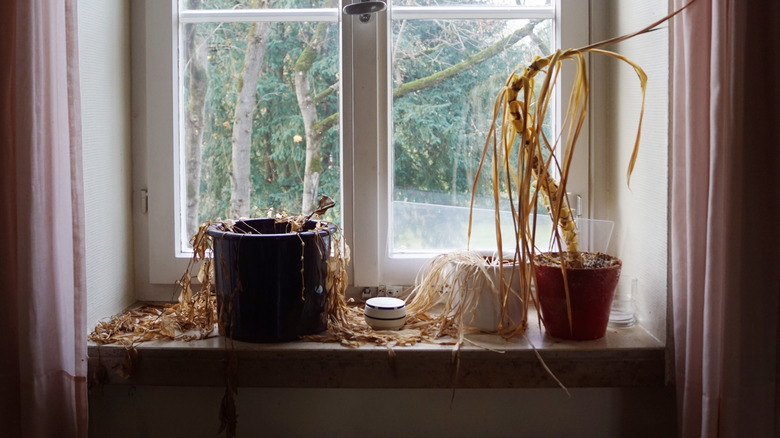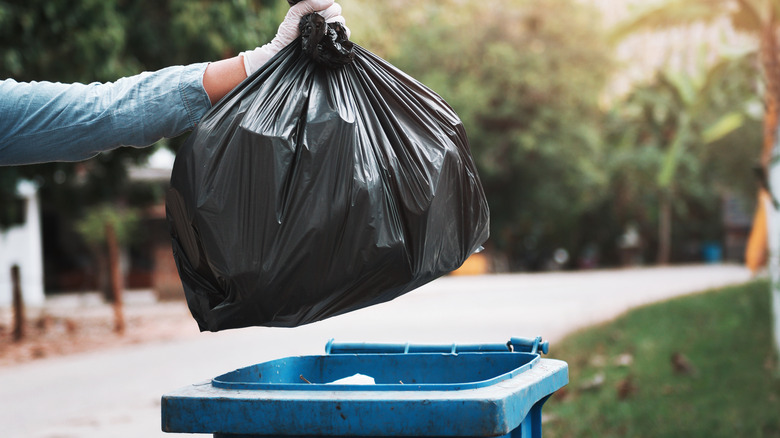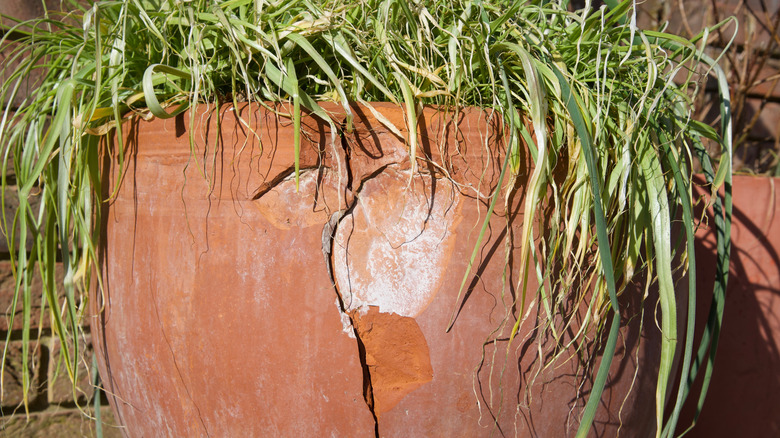How To Dispose Of Dead Potted Plants (And What To Save To Reuse)
Whether you consider yourself to be a bit of a pro indoor gardener or you're just starting out nurturing an Instagram-worthy urban jungle, losing one of your houseplants can be upsetting, and it's natural to blame yourself. It's important to remember that most indoor houseplants grow naturally in a tropical environment that can be a challenge to replicate. Try to look on the loss as a learning experience. Now you get to find out how to dispose of dead potted plants, and what to save and reuse for your next plant baby.
Alternatively, you may have had annuals growing in pots on your porch or patio that have come to the end of their life in early fall, and you're not sure whether you can reuse the soil, or whether the pots will be okay left out during the winter. It's a good idea to check if your plant is dead or just dormant before you throw it out, as perennials die back over the winter and come back to bloom during the following growing season. In this article we'll share the best way to dispose of dying or dead plants, how to recharge and recycle old soil, and what to do with old pots.
How to dispose of dead plants
When disposing of a dead plant the first thing you should work out is if the plant is really dead or dying, and the cause. This is because you could spread pests and disease. The easiest way to get rid of a dead plant is to bag it and bin it to quickly remove the plant from your house or garden, securing any pests and disease in the bag along with it. You should still check for signs that your other plants haven't been affected, as they may need treating.
Many people use ordinary plastic trash bags to dispose of dead houseplants, and put them out with the rest of the household waste. However, if you're looking for more eco-friendly advice, using compostable or paper bags is better for the environment. Go one step further, and throw them out with the garden waste. Alternatively, compost dead plants yourself. This might not be an option if your plant is diseased or infested with pests, as you'll want to minimize cross-contamination. If you don't have a garden waste collection or the means to self-compost, you can take dead plant material to your local waste and recycling center where they may have composting facilities for garden materials. Council composting facilities may be the safest option for infected plants. If this isn't practical due to having a small amount to dispose of, you may choose to burn the infected plant material yourself.
How to recycle old plant pots and soil
If your plant dies of "natural causes" like reaching the end of its natural life or suffering from environmental fluctuations – for example, over or under-watering, or not getting enough light — then it should be quite safe to reuse your plant pots and soil for a new houseplant. Signs of pests aren't always visible though, so be cautious and keep your new plant separate from others until you are confident it is safe.
To reuse the soil, first remove all previous plant matter like dead roots and leaves. You can use a sieve to filter the soil and remove clumpy bits. Next, sterilize the soil in a heated environment and by restricting airflow. You can do this by leaving it in the sun for a few weeks in an airtight container to kill bacteria and bugs. When using this method, be sure to add back in the nutrients lost with a good organic slow-release fertilizer. This will recharge the soil so it's ready for your new house or garden plant.
The best time to do this is in late fall. If you leave dead garden plants in their pots over winter the water and soil may expands and freeze, causing pots to crack. Instead, sanitize your pots with a scrubber and bleach and water spray using one teaspoon of bleach and one half gallon of water. Store them empty in a dry place like a garden shed or greenhouse.


